
Royal Australian Naval Volunteer Reserve
adapted from Lt-Commander Blackie by Graham Donaldson
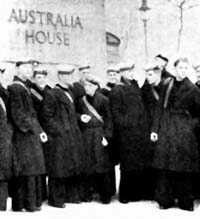
From its earliest days of sail and steam the Royal Australian Navy (RAN), while inevitably acquiring a history for itself, has always sought to absorb and profit from the rich traditions and heritage as an integral part of the Royal Navy (RN). Sea warfare can know no boundaries, and no matter who the enemy may be Australian waters are not always the logical place to defend Australian shores. Thus for many decades the RAN has a certain number of permanent naval officers serving with the RN, gaining valuable experience in all facets of projecting sea-power. While in exchange an appropriate number of RN officers bring their experience and training to the Australian fleet. At the outbreak of WWII the Admiralty accepted the Australian Naval Board's offer to provide personnel to serve with the HM Navy. The "Yachtsman Scheme" of volunteers, as it was termed, divided these wartime recruits into two age groups. Those over thirty were required to pass the navigation tests for a Yachtmaster Certificate, and were granted commissions before they left Australia. The younger volunteers reached the UK as ratings and were trained on watercraft from destroyer downwards, then entered HMS King Alfred training establishment to complete the courses for their commission.
The first shipment of volunteers under the "Yachtsman Scheme" left Australia in January 1940, with the largest group of RANVR's sailing
in February 1942 for Britain. There were approximately five hundred Australians representing
a small proportion of the Australian Navy on loan to the RN and most of the members were
RANVR. They served on a variety of warships, from the big battle-line vessels to the littlest
landing craft. In command or first lieutenancies in submarines to instructing in navigation or
anti U-boat work at shore bases, from gunnery to salvaging they carried out every type of duty.
The Admiralty deliberates carefully in selecting officers to command warships, yet there were
commands held by RANVR officers. One in command of a destroyer, another of a frigate, one
fleet mine-sweeper, captains of two corvettes, one submarine commander and Australian naval
volunteer officers leading four flotillas of tank landing craft. The command of a flotilla of
LCT's is a position of far greater responsibility and importance than is generally accepted.
Senior RN officers closely connected with Combined Operations have expressed the immense
difficulty of flotilla officers, in some respect, more difficult then that of a captain. Add
to the list the considerable multitude of little boats, the other types of landing craft,
attack torpedo and rescue vessels.
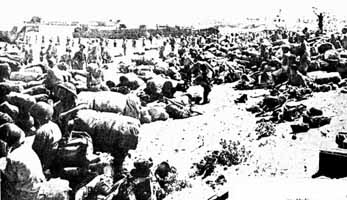
By early 1941 training in the use of landing craft was under way and a substantial number of
RANVR arrivals in Britain began active service in this early scene. A number of whom adapted
to amphibious warfare rather quickly and became senior officers, commanders of important
individual sea-craft, or instructors to British, other Dominion and US personnel in the fine
arts of lessons learnt in the application of amphibious assaults. Australians commanded positions
of the first wave of tank landing craft in the ill-fated raid at Dieppe in August 1942. In the
Mediterranean RANVR's were with landings at Sicily, Messina and Salerno most of the tanks and
other armoured fighting vehicles were taken to the assault beaches by participating Australians.
The Royal Naval seaman of yesteryears may have looked with inspired awe at the great Armada gathered at the invasion assembly ports. As long ago, far back in history the Normandy beaches were the goal of HM Henry V's fleet, English clinker-built ships to the practical design set centuries before by the Vikings in their amphibious hit & run raids. Now the Navy's allied ships of steel were to attempt the time and time repeated feat again, against Nazi Germans with the largest amphibious invasion army you'd ever read about in the pages of history books. The work towards the actual invasion beaches commenced on the morning of the day before the landing date. Minesweepers of every type were employed from big fleet sweepers to small motor craft clearing their allotted areas. 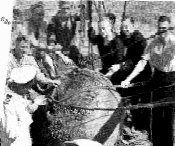
Before dawn the clear laneways had been widened and the minesweepers had worked so
thoroughly on the channels that there were no casualties from marine mines up to and during the initial
landings. Australians were well represented in this dangerous task under the guns of the enemy with one
Australian in command of a fleetsweeper and others scattered amongst the many anti-mine flotillas. One
Australian Reservist, on the night of 6 June, reckons that an enemy shore battery shell whistled over
the bridge of the ship he was on and smashed through the quarterdeck of the accompanying sweeper. The
shell ploughed through into a cabin, burst steampipes, cut electrical cords, buried itself into a
pillow and bounced into the wardrobe. The crew held its breath, waiting, listening for that dynamic
explosion yet none came. The crew dashed below into the steam and feathers, dragged the unexploded
projectile up on deck threw it overboard and continued on with their minesweeping action.
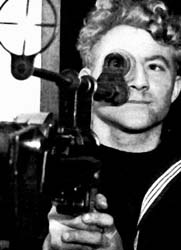
HMS Ajax had three RANVR lieutenants on board helping with the rest of the crew to destroy planned particular targets on D-Day morning. One as Officer-of-Quarters of a 6inch gun turret, the second was in charge of high angle anti-aircraft armament and the third as action Officer of the watch, important jobs nonetheless in the running of a tight fighting warship. The Navy's task in an invasion of enemy occupied coastal territory does not finish with the end of successful establishment on the beaches and beyond. The naval operations continue as long as the campaign lasts, as long as men and material have to cross the water. Many RANVR personnel are participating in this part of the battle during the following weeks since the 6th June 1944. In this case it's the smallcraft, motor torpedo boats, motor gunboats and other similar categories. A class of speciality derived from the time Australians began arriving in the UK and set the task of guarding Britain's coasts, and carrying the war into enemy waters. The invasion gave these traditional buccaneers the vital defence of countering E-boats and other forms of surface enemy interference. Escorting for minesweepers that commenced trans-Channel sweeps, served as special fast screen for convoys and the big bombardment warships. The success of the landings only brought them no respite, constantly moving, thwarting German attempts to counter attack by sea, or escape from southern French through the English Channel to ports in the north. One RANVR lieutenant who captained a MTB was stationed on the western flank and for ten days there were daily and nightly battle station actions with E-boats attempting to flee Cherbourg to the Channel Islands, of Guernsey and Jersey. 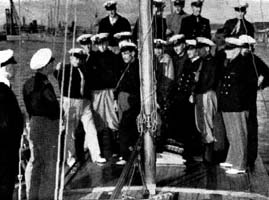
The peacetime yachtsmen who
answered the call of war by joining the RANVR, they like their countrymen and colleagues of the RAN
fought and died on the seas across the oceans of the world. For those who were with the RN in British
waters during the invasion, and those who earlier returned to Australia have gained the multitude of
experiences in the implementing of seapower which has paved the way for an amphibious assault onto a
heavily defended coast. They will return, or have returned with a wealth of knowledge in many branches
of naval warfare and to those Australians who follow in their cutting wake will be equipped with an
immense fund of information applicable to the defence of their island nation continent.
by Graham Donaldson |